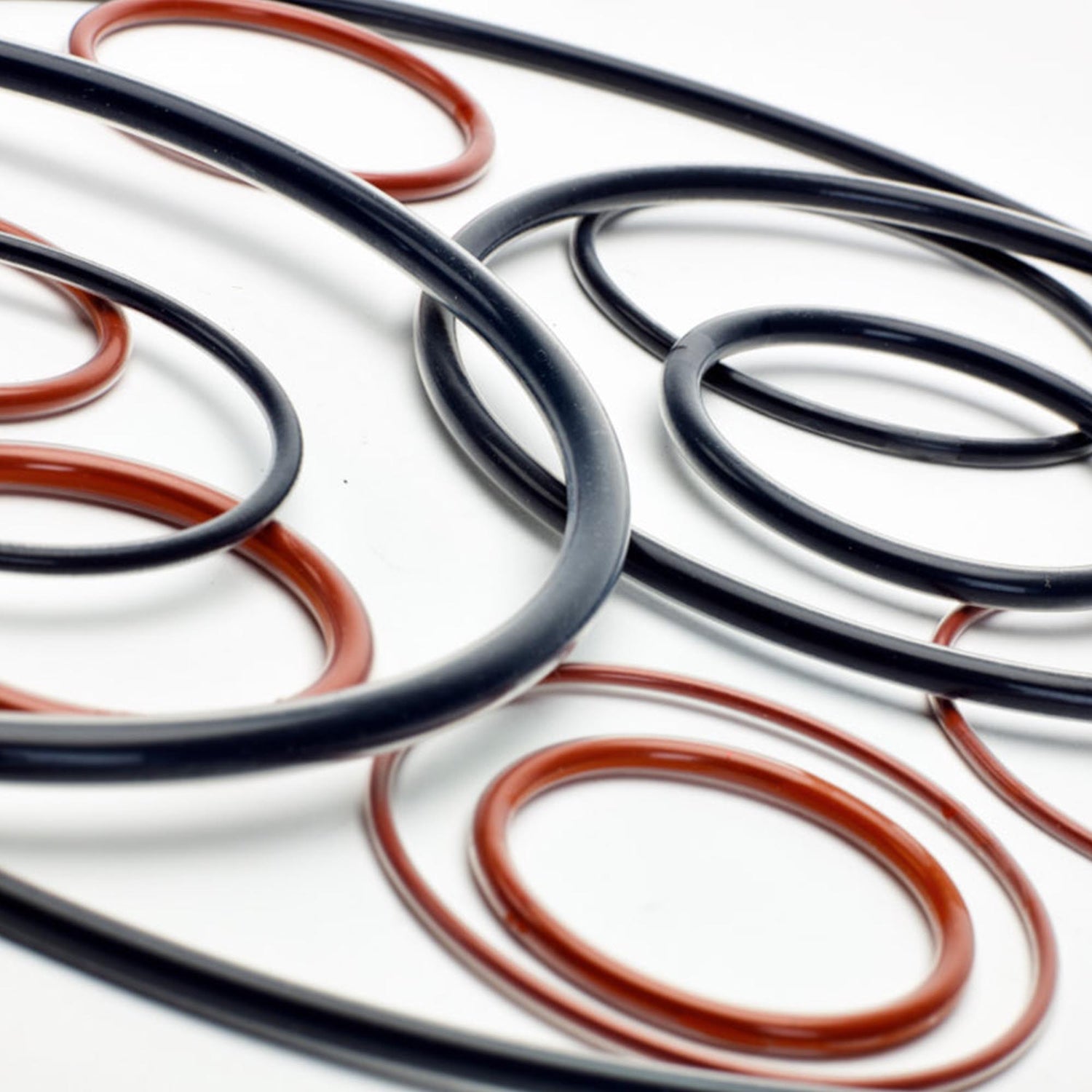
Encapsulated O-Rings

Need an encapsulated o-ring? No matter the size, big or small, we can help
We stock a large range of FEP and PFA encapsulated o-rings with Silicone and Viton inner core options, alongside circular, square and rectangle design options. We can provide both metric and imperial, as well as Kamlock sizes.
Encapsulated O-rings Guide
Encapsulated ‘O’-Rings consist of an elastomer core with a thin FEP or PFA sheath. The encapsulation is a hard material with limited flexibility compared to a fully elastomeric ‘O’-Ring.
Encapsulated O-Rings are commonly used in the food, pharmaceutical and chemical industries, and others where high chemical resistance and/or hygiene are required. They are better suited to static applications; however, they can be used in a dynamic applications if the movement is slow and short.
The elastomer core is either fluorocarbon (FKM) or silicone (VMQ) and can come in round, hollow or square/rectangular section.
An encapsulated O-ring is often recommended in certain circumstances where:
A standard O-ring has poor chemical resistance for a desired application
A solid PTFE O-ring does not offer the sufficient softness for the application
Sheeth Material Comparison
-
FEP (Fluorinated Ethylene Propylene)
-
PFA (PerFluoroAlkoxy)
-
Standard material for all applications up to 205°C, resistant to virtually all chemicals and joined by an advanced heat moulding process to give a seamless encapsulation.
-
Same properties as FEP encapsulation but with greater heat resistance for applications above 205°C. Also resistant to virtually all chemicals and joined seamlessly.
-
- Water Absorption: 0.3%
- Dielectric Strength: NULL volts per meter
- Flammability Rating (UL94 Rating): V-0
- Toughness: NULL
-
- Water Absorption: 0.1%
- Dielectric Strength: 1350 volts per meter
- Flammability Rating (UL94 Rating): V-0
- Toughness: R25
Inner Core Material Comparison
-
SIlicone (VMQ)
-
Viton (FKM)
-
- Recommended for extreme Temperatures (High or Low)
- Softer shore hardness - better suited to static applications
- Resistant to Ozone
- Compression set Resistant
-
- Recommended for chemical resistance
- Generally better suited to dynamic applications
- Resistant to Ozone
- Compression set Resistant
Encapsulated O-Ring Inner Core Types
Silicone Solid Inner Core
Commercially Silicone is the best material option combined with lower Shore Hardness and greater elasticity than Viton®, providing an excellent material choice for the majority of applications.

Viton Solid Inner Core
As opposed to Silicone, Inner Viton® has greater chemical resistance than Silicone. If encapsulation is damaged, Viton® provides greater resilience to chemical attack.

Silicone Hollow Inner Core
Hollow core flexibility means less firmness to further increase its sealing abilities. Recommend for delicate applications using sensitive materials such as glass or light plastic. Available in Silicone or Viton Materials.
IMPORTANT NOTE! Not to be applied within vacuum applications. Negative air pressure within the hollow core can cause a rupture.

Silicone/Viton Square Section Inner Core
Specifically designed to be a gasket seal, square shaped encapsulated seals are more suited to specific requirements and are available in Silicone or Viton materials.

Silicone/Viton Rectangular Inner Core (Kamlock)
The rectangular shape cross-section is designed to be a universal fit and precludes the need to specify different elastomers for different applications. This in turn also helps prevent coupling leakage due to a chemical attack or cold extrusion of a solid PTFE gasket seal. These are also available in Kamlock™ sizes.
What are Encapsulated O-ring seals?
Encapsulated O-rings are sealing components that consist of an elastomer core and a seamless fluoropolymer (commonly PTFE) encapsulation. This design combines the flexibility and elasticity of the core material with the chemical resistance of the encapsulating material. Encapsulated O-rings are used in various industries where standard elastomer O-rings would degrade due to aggressive chemicals or extreme temperatures.
How do Encapsulated O-ring Seals work?
Encapsulated O-rings work by providing a tight seal between two surfaces. The elastomeric core allows the O-ring to maintain its shape and provide the necessary compression to form a seal, while the PTFE encapsulation protects the core from chemical attack and extreme temperatures. When compressed between two mating surfaces, the O-ring deforms to fill the gap, creating a barrier that prevents the passage of fluids or gases.
What are the benefits of Encapsulated O-ring Seals?
- Chemical Resistance: The PTFE encapsulation provides excellent resistance to a wide range of chemicals, making these O-rings suitable for aggressive environments.
- High Temperature Resistance: Encapsulated O-rings can withstand high temperatures, which allows them to be used in applications where standard O-rings would fail.
- Durability: The combination of a flexible core and a tough encapsulation layer results in a durable seal that can handle dynamic applications and frequent temperature cycling.
- Low Friction: PTFE has a low coefficient of friction, which reduces wear and tear on the O-ring and the mating surfaces, extending the service life of the seal.
- Versatility: Suitable for a wide range of applications, including chemical processing, food and beverage, pharmaceuticals, and more.
What are the Different Types of Encapsulated O-rings Seals?
- FEP Encapsulated O-rings: Fluorinated ethylene propylene (FEP) encapsulation provides excellent chemical resistance and is suitable for a wide temperature range.
- PFA Encapsulated O-rings: Perfluoroalkoxy (PFA) encapsulation offers even greater chemical resistance and higher temperature tolerance compared to FEP, making them ideal for the most demanding applications.
- Silicone Core: Encapsulated O-rings with a silicone core provide good flexibility and are suitable for high and low-temperature applications.
- Viton® Core: Encapsulated O-rings with a Viton® core offer superior chemical resistance and high-temperature performance.
How to Choose the Right Encapsulated O-rings?
- Chemical Compatibility: Ensure the encapsulating material (FEP or PFA) is compatible with the chemicals in your application to prevent degradation.
- Temperature Range: Select an encapsulated O-ring that can withstand the operating temperature range of your application.
- Application Requirements: Consider the specific needs of your application, such as the required flexibility, pressure conditions, and regulatory compliance.
- Core Material: Choose a core material (e.g., silicone or Viton®) that provides the necessary elasticity and resilience for your operating conditions.
- Size and Fit: Ensure the O-ring fits the dimensions of your sealing groove correctly to provide an effective seal.
Order before 2pm to get same day dispatch next day delivery
Need help with an encapsulated o-ring?
Let our expert team find the right product for you
